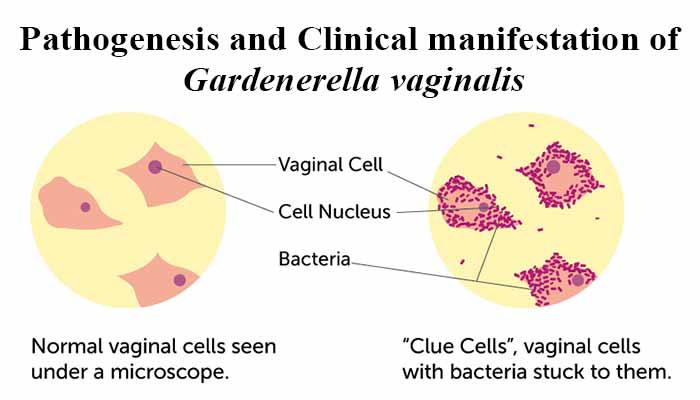Interesting Science Videos
Pathogenesis of Gardenerella vaginalis
A. Adherence of G. vaginalis to Host Epithelium: Initial Steps in Invasion
- The initial steps of establishing infection include adherence to host receptor sites, production of cytotoxic substances specific for host cells, and biofilm formation.
- vaginais produces vaginolysin, a cholesterol-dependent cytolysin, for human cells and encodes a pore-forming toxin that binds to the CD59 human complement regulatory molecule.
- This cytotoxin assists in the initial adherence of G. aginalis to the host epithelial cells.
- G. vaginalis demonstrates three virulence factors; vaginolysin, biofilm formation by action of sialidase activity and cytotoxin and suggested that the other organisms may be relatively avirulent opportunists that colonize after initiation of infection by G. vaginalis.
- G. vaginalis has the greatest capacity to adhere to epithelial cells in the presence of Lactobacillus crispatus.
B. Mechanism of infection
- Subsequent to initial adherence to the host cell, the invading bacteria multiply and may produce a biofilm community as a means of future survival.
- Production of biofilm is critical to the survival of G. vaginalis in the vagina.
- Sialidase, which is produced by some strains of G.vaginalis, may enhance production of biofilm through its mucinase activity.
- Biofilms of G. vaginalis is tolerant to lactic acid and hydrogen peroxide produced by lactobacilli.
- Once this critical mass of bacteria is present, quorum sensing or bacterial potential, which is then suitable for the overgrowth of strict anaerobes, normally present in very low numbers.
- In addition, G. vaginalis is a proteolytic bacterium that produces amino acids through its metabolism. It has been shown that Prevotella bivia, a strict anaerobe, uses amino acids as its fuel source and as a result produces ammonia, which in turn is used by G. vaginalis.
- A symbiotic relationship between vaginalis and strict anaerobes is another mechanism whereby G. vaginalis enhances the growth of anaerobes in the vagina.
- This symbiotic relationship with the production of ammonia would cause a shift to a more alkaline pH, which is not suitable for to lactobacilli and enhance greater multiplication or presence of G. vaginalis and other anaerobes which leads to bacterial vaginosis.

Clinical manifestation of Gardenerella vaginalis
Bacterial vaginosis
- Bacterial vaginosis (BV) is an abnormal vaginal condition that is characterized by vaginal discharge and results from an overgrowth of atypical bacteria in the vagina. It is not a true bacterial infection but rather an imbalance of the bacteria that are normally present in the vagina.
- Anaerobic organisms, including Prevotella spp., Porphyromonas spp., Bacteroides spp., Peptostreptococcus spp., Mobiluncus spp, Mycoplasma spp., Fusobacterium and Eubacterium as well as G. vaginalis, seems to contribute to the pathology of BV.
- The infection typically occurs in sexually active women.
- Clinical features of bacterial vaginosis include
- Offensive vaginal discharge
- High ph more than 4.5
- Perivaginal irritation (itching around the outside of the vagina)
- A thin white or gray vaginal discharge
- A strong fish-like odor (the vaginal discharge and odor are often more noticeable after sexual intercourse)
- Pain, itching, or burning in the vagina
- Burning when urinating/painful urination
- abdominal discomfort

Iam lukman gambo from Nigeria studying .microbiology as my interesting course,and i wan to due my masters at Nepal just to meet you SAGAR ARYAL, how can I reach you.
Thanks for sharing
Welcome 🙂
Thanks for sharing
Welcome 🙂